If you have recently visited a hospital or airport, it’s possible you will have seen therapy dogs helping patients and passengers. Therapy dogs bring a wide range of benefits for those who seek their help, whether they are flying to a distant country and feel anxious about doing so, or are stuck in hospital recovering from an operation. Therapy dogs bring both comfort and care to all they come into contact with.
However, a therapy dog has to go through many stages before they are approved to be certified as a therapy animal. Interacting with many different people daily is part of this as the dog will have to provide affection and elevate the patient’s mood, for example. In this article, you’ll be provided with simple items and steps that will help to teach your dog about their surroundings.
11 Effective Ways to Comfort Your Dog
- Leash Manners
Taking your therapy dogs to hospitals or seniors home will help them get familiar with the noise and surroundings. You will be able to evaluate your dog’s tendencies knowing whether to provide more home training or not. For instance, if your dog was to come into close contact with someone in a wheelchair, it might cause them to react in a certain way. So, beforehand, it will be better walking your dog on a leash so that they can get used to the idea of direction and having someone guide them. When this has been mastered with some basic commands followed up, your dog will hopefully be able to walk on a loose leash or freely by itself while sitting politely in front of a patient waiting for a longing stroke. - Trying Different Scenarios
Your dog will come across patients that are ill and distressed, and they need to be able to deal with this calmly. To ensure they do so, make your dog practice putting their head on yours or laying across your bed, which will help make the patients feel better in a real-life situation. Even when faced with behaviors such as emotional stress or anxiety, your dog will show no distress, making sure to keep the patient as calm as possible.Depending on the patient, the dog will be positioned towards the end of the bed but preferably close to the patient, so it is in close reach of some gentle cuddles. - Floor Surfaces
Some metal grates that you come across when walking your dog can spook them by the noise it makes. Without paying attention, this could scare your dog, so you’ll need to listen carefully to the sound next time it comes around.Doing so will come in handy when pairing the noise to something your dog loves. To get over the fear, you can use objects or pet toys. Any other metal vibration your dog will come in contact with will not alert the dog. Even though it may take some time, your dog will be walking over that daunting piece of metal in no time. - Children
Through training your dog, he or she will begin to be aware of regular movement but not so much when being around children. It’s important to have your dog come into contact with many different people regularly, especially playing with children that make sudden movements and loud noises at any given time. When your dog faces such activity in their therapeutic work, they won’t be so disturbed and instead be calm and prepared for the noise and movement. - Practice
Teaching your dog tricks like roll over, sit, and lie down should come with positive rewards and good attention during training. When your dog completes the trick, you should follow this up by the clicker as the dog will predict a treat coming along. You should repeat this often as it will keep your dog engaged in a regular routine. - Encountering Other Dogs
Taking your dog for a walk through the park is probably a routine for you already, but your dog may meet other pets which could lead to a problem arising and escalating. So, you’ll have to take command and use the skills you have learned. If your dog reacts well around other dogs in the park, you can introduce yourself and your dog to a fellow pet owner, so they are ready to meet various animals calmly. - Dealing with Separation
Leaving your dog alone with someone else will test if the dog is suitable to be in the presence of strangers. It will show you whether your dog can last short periods or longer periods without you. - Dog Uniforms
Most therapy dogs will wear a dog vest that identifies them, but it may not always be present. Other clothing will consist of a bandanna for therapeutic purposes or even an identification tag. It’s important to get your dog used to wear such uniforms before they have to wear one for an extended period. - Checkup and Appearance
Therapy dogs should be having a checkup with the veterinarian each year so they get their mandatory vaccination as they might catch infections or illnesses. It will test if your dog allows someone other than you to check its weight, teeth, etc. without hassle. As the vet won’t be there all the time, investing in your own grooming brush will help take care of your dog’s excess hair. - Exercise
Make sure that your dog receives regular exercise in and out of training sessions. It doesn’t mean that your dog has to push through major lessons of exercise, but if your dog likes to play ball, play it but make it a challenge to get it more energized. Providing your dog with more challenges will give them an eagerness to learning and a willingness to listen.If you need recommendations to combine activities and training ideas, you should ask other trainers who have experience in training therapeutic dogs. - Relationships
This is the most important tip to remember when training your dog. You should focus on building an honest, healthy relationship with your dog. You will guide and support your dog through their learning and use suitable but effective techniques to accommodate this. Every interaction you do with your dog should be relaxed and must implement a solid foundation.
Provided you have a close relationship with your dog beforehand, it should come easy to you when using verbal and visual language.



